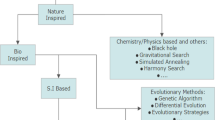Abstract
Particle Swarm Optimization (PSO) is an effective, simple and promising method intended for the fast search in multi-dimensional space [Kennedy and Eberhart, "Particle Swarm Optimization", Proc. of the 1995 IEEE International Conference on Neural Networks, 1995]. Besides special testing problems a number of engineering tasks of electrodynamics were solved by the PSO successfully [Robinson and Rahmat-Samii, "Particle Swarm Optimization in Electromagnetics", IEEE Trans. Antennas Propag., 2004; Jin and Rahmat-Samii, "Parallel Particle Swarm Optimization and Finite-Difference Time-Domain (PSO/FDTD) Algorithm for Multband and Wide-Band Patch Antenna Designs", IEEE Trans. Antennas Propag., 2005]. On the other hand, the scattering matrix technique is a fast and accurate method of mode converter analysis. We illustrate PSO by a number of converter designs developed for high-power microwaves control: a matching horn for output maser section, a corrugated converter of linear-polarized hybrid modes, a TE01 mitre bend.


















Similar content being viewed by others
References
J. Kennedy, and R. Eberhart, Particle Swarm Optimization. Proc. of the 1995 IEEE International Conference on Neural Networks. (IEEE Press, 1995), pp. 1942–1948.
J. Robinson, and Y. Rahmat-Samii, Particle Swarm Optimization in Electromagnetics. IEEE Trans. Antennas Propag. 52(2), 397–407 (2004), Feb.
N. Jin, and Y. Rahmat-Samii, Parallel Particle Swarm Optimization and Finite-Difference Time-Domain (PSO/FDTD) Algorithm for Multband and Wide-Band Patch Antenna Designs. IEEE Trans. Antennas Propag. 53(11), 3459–3468 (2005), Nov.
M. Clerk, and J. Kennedy, The particle swarm-explosion, stability, and convergence in a multidimensional complex space. IEEE Trans. Evol. Comput. 6(1), 58–73 (2002).
R. C. Eberhart, and Y. Shi, Comparing inertia weights and constriction factors in particle swarm optimization. Proceedings on IEEE Congress on Evolutionary Computation 2000. (San Diego CA, 2000), pp. 84–88.
A. Carlisle, and G. Dozier, An Off-The-Shelf PSO. Proc. of the 2001 Workshop on Particle Swarm Optimization. (Indianapolis, IN, 2001), pp. 1–6.
J. M. Nelson, P. E. Latham, M. Caplan and W. G. Lawson, Determination of the resonant frequencies in a complex cavity using the scattering matrix formulation. IEEE Trans. Microwave Theor. Tech. 37(8) 1165–1169 (1989).
C. Granet, G. L. James, R. Bolton, and G. Moorey, A Smooth-Walled Spline-Profile Horn as an Alternative to the Corrugated Horn for Wide Band Millimeter Wave Applications. IEEE Trans. Antennas Propag. 52, 848–854 (2004).
A. V. Chirkov, G. G. Denisov, and N. L. Alexandrov, 3D Wavebeam field reconstruction from intensity measurements in a few cross-sections. Opt. Commun. 115(5) 449–452 (1995), Apr.
V. L. Belousov, A. A. Bogdashov, G. G. Denisov, A. V. Chirkov, and S. V. Kuzikov, New Components for TE01 Transmission Lines. Proc. Int. Workshop Strong Microwaves in Plasmas, Nizhny Novgorod, vol.2, pp. 948–953 (1999), August 2–9.
A. Bogdashov, G. Denisov, D. Lukovnikov, Y. Rodin, and J. Hirshfild, Ka-Band Resonant Ring for Testing Components for a High-Gradient Linear Accelerator. IEEE Trans. Microwave Theor. Tech. 53(10), 3152–3154 (2005), October.
E. A. Marcatili, Waveguide Elbow / US Patent 3.090.931.C1.333-98; Filed Mar.8, 1962.
R. B. Vaganov, and V. U. Z. Izvestiya, Radiofizika 12 630–635 (1969).
J. L. Hirshfield, O. A. Nezhevenko, M. A. Lapoiter, and V. P. Yakovlev, Technology Developments for a Future Millimeter-Wave High-Gradient Linear Accelerator. 2004 Joint Int. Conf. on Infrared and MM Waves, Conference Digest, 529–530.
Acknowledgements
Authors would like to thank Prof. M.I. Petelin, Dr. N.Yu. Peskov and S.Yu. Kornishin, A.V. Chirkov for their help and support.
Author information
Authors and Affiliations
Corresponding author
Rights and permissions
About this article
Cite this article
Bogdashov, A.A., Rodin, Y.V. Mode Converter Synthesis by the Particle Swarm Optimization. Int J Infrared Milli Waves 28, 627–638 (2007). https://doi.org/10.1007/s10762-007-9248-2
Received:
Accepted:
Published:
Issue Date:
DOI: https://doi.org/10.1007/s10762-007-9248-2




